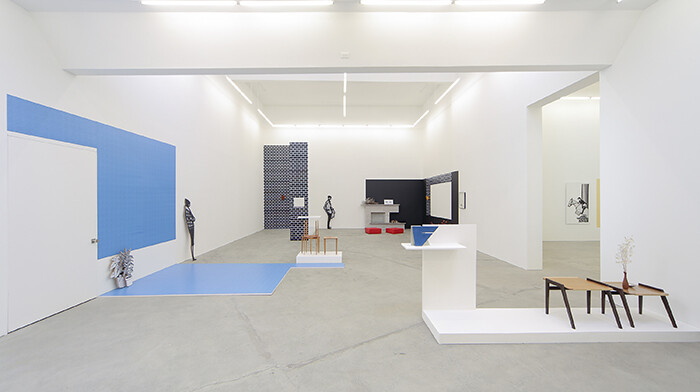Models are used in architectural practice to represent and communicate ideas. In “Pre-arranged Comfort,” artist Katarina Burin transforms San Francisco’s Ratio 3 into a 1:1 model that proposes an exhibition of the work of designer and activist Fran Hosken (b. 1920). Burin has constructed four spaces that compose an immersive environment, each staging a curated selection of photographs, architectural drawings, texts, and design objects, a combination of historical and newly recreated material loosely inspired by Hosken’s work. Extracting relevant characteristics of the designer’s history, Burin’s material landscape brings Hosken’s aesthetic ambitions to life.
In 1944, Hosken was among the first women to receive a master’s degree from the Harvard Graduate School of Design (GSD). In 1951, she established a design business, Hosken Inc., which produced jewelry and furniture. Hosken attempted to collaborate with modernist greats, such as Walter Gropius, but her various efforts failed, and in 1963 she closed her company and sued GSD for sexual discrimination, a decision that foreshadowed her later work as a female rights activist.1
Through the staging of exhibitions of real and imagined material, Burin assumes the roles of archivist, artist, and designer, as in her 2012 exhibition at Ratio 3, “Andrejova-Molnár Papers,” a project dedicated to the history of a fictional modernist architect, P.A. (Petra Andrejova-Molnár).
Hosken and P.A. are both eccentric and ambitious females who slipped through the cracks—both real and imagined—of architectural history. As with her work on P.A., Burin does not put Hosken’s biography front and center in the exhibition; rather, she uses Hosken’s photographs and designs as the framework for an immersive environment. Like the exhibitions of Kazimir Malevich, whose work repeated materials and shapes to construct a continuous composition, Burin’s exhibition is a total work of art. Bold swaths of colored and patterned vinyl appear as fragments of a larger whole, directing visitors through the expertly curated spaces. Recurring signs reading “Žijeme” (Žijeme Drawing (We are Living), 2014) which roughly translate to “we are alive” or “we are living” in Slovakian, along with portraits of Hosken (Hosken Documentation Photographs in the Studio and Smoking, 2014), hint at a culture and protagonist in the setting of the exhibition. In locating Hosken’s work in a Slovakian context, as well as in presenting historical images of the designer, text and photographs contextualize and link the exhibition’s fragmented spaces.
Burin’s interest lies in the modern expectations built into pre-arranged surroundings. She uses single planes to imply a series of deconstructed interior rooms in which objects are detached from formal settings. In doing so, the artist presents a complex sequence of spaces that, by accentuating and thereby distorting notions of comfort, efficiency, and sophistication, quietly challenge modern myths of domesticity and design.
In the first room, we see the traditional elements of an architecture exhibition: a framed drawing and model of a high-mountain lodge (Slovakian Mountain Chalet, 2014) flanked by a scaled silhouette of a pine tree (Letraset Pine Tree for the Chalet, 2014) and an untitled bold band of black vinyl, over which is mounted an obscure emblem for what appears to be a high-mountain lodge (Exterior Sign - Vysoké Tatry (High Mountains), 2014). Here, the scale and placement of the material suggest a holistic and slightly distorted setting.
There are further shifts in scale throughout “Pre-arranged Comfort” that contribute to the abstract quality of the space. In the last and fourth room, an untitled wall piece is covered with a magnified and thus abstracted image of fur, complimented by a bright band of yellow vinyl immediately behind it. An ink drawing of a woman riding a horse (Equestrian Drawing, 2014) is mounted at the end of the vinyl. Both the horse and rider are looking straight ahead as the horse leaps into the white space of the gallery. In this last room, Burin blurs the scale—and therefore the distinction between object and environment—most successfully. She uses the massive image of fur as the backdrop for a staging of a surreal and modeled interior.
The exhibition includes ubiquitous props of modernist design such as side tables, vases, and light fixtures, whose provenance raises questions of authenticity and authorship. For example, a collection of wall sconces (Chalet Wall Sconces, 2014) was produced by Burin, while a set of stacking tables (Hosken – 4 Small Stacking Tables, circa 1950) was designed by Hosken. The combination of both artists’ work is undetectable, as no label is present to clarify the origin of the material. As such, there is a play between design and art, originals and reproductions, fabricated and suggested interiors. Like the materials used in model-making, the exhibition’s walls and surroundings are proxies for an actual architecture.
As it exists in this transitional space between fact and fiction, “Pre-arranged Comfort” represents both the presence—in its presentation of archival materials—and absence—in its lack of historical context—of architectural discourse. The text intervention in the last gallery—“Žijeme”—evokes the continued relevance of Hosken’s design history and points to the real ambition of Burin’s work: in reviving the legacy of Hosken through the modeling of a new reality, the artist sustains the designer.
Conversation with Katarina Burin, San Francisco, November 4, 2014.









